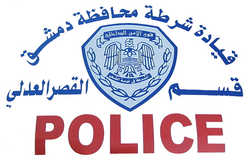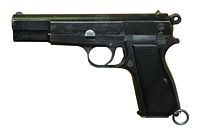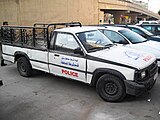Public Security Police (Syria)
| Public Security Police شرطة الأمن العام shurtat al'amn aleami | |
|---|---|
 | |
| Common name | Syrian Police, Internal Security Forces |
| Abbreviation | SPSP/SP |
| Motto | الشرطة في خدمة الشعب Police is for the service of people |
| Agency overview | |
| Formed | 1945[1] |
| Preceding agency | |
| Employees | 28,000 (2016) |
| Annual budget | LS 7,825,000[2] |
| Jurisdictional structure | |
| National agency (Operations jurisdiction) | Syrian Arab Republic |
| Operations jurisdiction | Syrian Arab Republic |
| Size | 185,180 km2 |
| Population | 18,437,288 |
| Legal jurisdiction | Criminal Code |
| Governing body | Criminal Security Directorate |
| General nature | |
| Operational structure | |
| Headquarters | Damascus, Syria |
| Agency executive | |
| Parent agency | Ministry of Interior |
| Facilities | |
| Patrol cars | Opel Omega B1, Opel Omega B2, Honda Accord, Ford Courier, Beijing BJ212, Toyota Land Cruiser, Toyota Hilux |
| Armoured personnel carriers | BTR-60, BTR-152, BRDM-2, Shortland Mk 3, Shortland Mk 4[3] |
| Helicopters | at least 2 MI-171SH |
| Notables | |
| Anniversary | |
| Website | |
| http://syriamoi.gov.sy | |
The Public Security Police (Template:Lang-ar) is the main police service of Syria.[6]
History
Police system
The person who manages the police is the Director General, whose superior is the Minister of the Interior through the Criminal Security Directorate. Special metropolitan police are in Damascus, Aleppo, and other major cities overseen directly by the Director General.
Alongside with other Directorates, the Ministry of Interior controls the Internal Security Forces, through the Criminal Security Directorate, which are organised into at four separate divisions of police forces under a Director General: Administrative Police (Public Order Police), Traffic Police (whose official Day is on 4 May), Criminal Investigations, and Riot police, as well as a fanfare and the Khan al-Asal Police Academy.[7]
The internal security is partially separated from the police, the main internal security agencies are: Political Security Directorate and General Security Directorate.[8]
Territorial organization
At territorial level, the Syrian police is organized into Police Provincial Commands, each led by a major general, who is assisted by a brigadier general acting as a deputy.[9][10] The Operations Department is directed by another Brigadier General.[11] Districts are headed by Directors ranking Colonel to Brigadier General,[12] while Subdistricts are led by junior Officers. As of October 2021, the Commander of Damascus region is Major General Hassan Jumaa. Also, as of June 27, 2021 Brig. Gen. Dirar Dandel is the commander of Daraa Governorate.
Equipment, uniforms, personnel and training
Police Equipment
Syrian police equipment is an issue. According to The Telegraph, which cites WikiLeaks, the Syrian police was supplied with advanced radio communications equipment, including 500 hand-held VS3000 radios, by Finmeccanica as late as 2011.[13]

According to pro-militant website Zaman al-Wasl, in 2014 the Ministry of Interior received two Russian MI-171SH helicopters.[14] Regular police units appear to be equipped with the AKM assault rifle and the Browning Hi-Power, Makarov PM and GSh-18 pistols.[15][16]

Elite police units, such as Special Mission Forces, are equipped with AK-103 and AK-104 assault rifles.[17][18]
Police uniforms
Police uniforms vary according to the police branch which it is considered. Generally speaking, policemen assigned to security tasks wear the military olive green with garrison caps,[19] but also camouflage.[20]

Since 2009, the Government has decided to change traffic policemen's uniforms from military olive green to grey pants, a white shirt with yellow shoulder patches and black belt and shoes.[21]

As of 2011, Anti-terrorism police wore dark blue uniforms.[22]
Ceremonial uniforms consist in jackboots, white peaked cap and white tunic, with dark trousers with a red trim for infantry and motorcycle units, and white cavalry pants for mounted troopers.[23] or, its task are limited to the protection and enforcement of security.[24]

The Internal Security Forces are part of the Ministry of Interior but makes uses of military ranks.[25]
Police vehicles
-
Opel Omega B1 Caravan emergency police patrol car
-
Opel Omega B2 Caravan public order police patrol car
-
Mazda Courier pickup truck
-
Mazda Courier pickup truck, in the background Toyota Land Cruiser FJ40 Hard Top
-
Police tow truck
-
Suzuki motorcycle
Personnel
As for total manpower of the Syrian police, in 2011 reportedly were about 100,000 police plus reserves,[26] while 2016 estimates put the total force of 28,000 personnel,[27] and 8,000 to 9,000 injured soldiers.[28] Syrian women are allowed to serve (although not in frontline units)[29] and to reach senior positions.[28]
Operating methods
The police reportedly undergo military-type[19] and counter-terrorism[29] training. Community policing is also a large element within the country of Syria. Citizens in Syria began using cyber community policing tactics via social media as a way to address the conflict happening around them. Doing so has given them some power to influence change in their environment. Their efforts demonstrate that global cyber community policing programs have the ability to connect communities and create social media networks that can effectively and proactively address, and hopefully prevent, threats to its citizens.
Training
The police reportedly undergo military-type[19] and counter-terrorism[29] training, having a school in al-Hasakah.[30] Education for all police personnel is provided at three institutes: two central Police Training Schools in Damascus and Aleppo - Khan al-Asal Police Academy and the Officers College in Homs, where junior officers are sent for six-month courses in specialized areas of expertise.[31]
Criminal Security Directorate
Within the Criminal Security Directorate there are five Divisions and branches:
- The Administrative Police is also known as Public Order Police: they are responsible for general security and deal with non-emergency situations.[32]
- The Emergency Division deals with emergency situations, operating roving patrols. The emergency number is 112.[32]
- Traffic Police (emergency number is 115)[5]
- Criminal Security Department;[33]
- Riot Division;[34]
- Electronic Criminal Branch, in charge of combating computer- and web-based crime. According to pro-government newspaper Al-Watan, the Electronic Criminal Branch has a dedicated criminal laboratory.[35]
At the central level, the Directorate is the body in charge for relations with INTERPOL, of which the country has been a member since 1953.[36] [37]
As of October 2021, Syria was readmitted to INTERPOL’s global police communications network after being subjected to restrictive measures since 2011, thereby allowing Damascus to access databases, communicate with the other 194 members, and issue international arrest warrants, called "red notices".[38] [39]
Also has an its own Commission for combating money laundering in cooperation with the Commission of the same name at the Central Bank of Syria.[40][41]
Since 8 July 2019, the head of the Criminal Security Directorate is General Nasser Deeb, former head of the Hama branch of the Political Security Directorate and former assistant director of the Damascus branch.
Criminal Security Department
The Criminal Security Department is the subdivision of the Criminal Security Directorate which is in charge for general investigative police duties.[42] Police records in Syria are maintained by the Ministry of Interior, Criminal Security Department and separate records are maintained by each jurisdiction: some jurisdictions are computerized, but there is no central computerized database.[43]
Within the Criminal Security there is a subdivision known as the "Department of Protection of Public Moralities", tasked with investigating suspect homosexuals and their activities.[42]
As of 2021, the director of the Criminal Security Department is General Hussein Jomaa.[33]
Riot police
The Riot police (Template:Lang-ar Qiwa Hafz al-Nizam)[44] is part of the Criminal Security Directorate.[34]
The riot police core missions are to provide tactical security, crowd control and riot control for demonstrations. In Damascus, the riot police is also used in order to protect diplomatic missions against protestors.[45][46][47][48]
Riot Police is organized into Battalions and Brigades.[49] During the Syrian war, the riot police has been used in order to break early protests; according to pro-opposition opinionists, it even opened fire on demonstrators.[50]

Syrian riot police is issued typical riot equipment, such as riot helmets, tonfa, rubber batons,[51] shields, body armor, bulletproof vests, rubber bullets and plastic bullets.[52][53]
Other heavier equipment includes armoured personnel carriers, water cannons,[54] tear gas and pepper spray.[55] The riot police is also reportedly equipped with armoured vehicles.[56]
Policemen assigned to security and riot control duty wear the military olive green with garrison caps,[19] but also camouflage.[20]
Anti-Narcotics Directorate
The Anti-Narcotics Directorate, independent from the Criminal Security Directorate since 1996, has responsibility for anti-drug law enforcement and intelligence gathering.[57]
The anti-narcotics establishment was separated from the police in 2002 and made an independent Directorate within the Ministry of Interior. Before the outbreak of the Syrian War, the Government also operated regional counternarcotics offices in Aleppo province and in Homs province, with plans to open offices in the remaining provinces.[58]
The work of the Anti-Narcotics Directorate is specialised in guiding and coordinating efforts aimed at fighting the illicit traffic, plantation and use of drugs, plans the fight against drugs in coordination with other authorities, executes international anti-drugs operations, and collects information on drug crimes.[40]
As of 2006, the Anti-Narcotics Directorate was subdivided into:[40]
- Internal anti-drug division;
- International anti-drug division;
- Information division;
- Rehabilitation and training division.
Specialist organizations
Aside of the general police, there are also other specialized organizations, such as the Gendarmerie for control in rural areas and the Desert Guard for border control (especially the Syrian-Iraqi border), up to 10,000-men strong.[59] These latter two organizations have a military character.
For ceremonial duties, the Internal Security Forces also have a cavalry battalion based in Damascus.[23] Other element of the internal security, albeit separated by the Internal Security Forces and by the Ministry of the Interior, is the Military Police.
Syrian Special Mission Forces
See also
- Ministry of Interior (Syria)
- Law enforcement in Syria
- Judiciary of Syria
- List of equipment of the Syrian Army
References
- ^ Lawson, Fred Haley (1996). Why Syria Goes to War: Thirty Years of Confrontation. Ithaca, USA: Cornell University Press. p. 163. ISBN 9781501731860.
- ^ "Syrian government budget". Syria Direct. 18 March 2020. Retrieved 2 October 2021.
- ^ "Trade Registers". Armstrade.sipri.org. Retrieved 2015-01-01.
- ^ "29th May, Syrian Internal Security Forces Day". Syrian Arab News Agency. 29 May 2015. Retrieved 25 December 2016.
- ^ a b "Festival held at Umayyad Square on the occasion of World Traffic Day". Syrian Arab News Agency. 4 May 2018. Retrieved 2 February 2022.
- ^ "Country profile-Syria" (PDF). reliefweb.int. Retrieved 1 November 2021.
- ^ "En pleine guerre, la police syrienne recrute des musiciens". LaPresse.Ca. Agence France-Presse. 5 November 2013. Retrieved 13 September 2015.
- ^ John Pike. "Syria Intelligence and Security Agencies". Globalsecurity.org. Retrieved 2012-07-21.
- ^ "Deputy police chief in Syria's Latakia flees to Turkey". The Jerusalem Post. REUTERS. 30 July 2012. Retrieved 13 September 2015.
- ^ "Assad appoints new police commander to end tension in Hama". en.zamanalwsl.net (in Arabic). 5 December 2019. Retrieved 30 March 2020.
- ^ "Changes in Suweida Internal Security Apparatus". SUWEIDA 24. 12 August 2020. Retrieved 2 September 2020.
- ^ "Syrian antiquity smugglers apprehended". en.royanews.tv. 1 October 2018. Retrieved 11 December 2018.
- ^ Squires, Nick (5 July 2012). "WikiLeaks begins publishing tranche of Syria emails". Telegraph. Retrieved 14 September 2015.
- ^ Hadad, George; Ahmed, Yusra (20 April 2014). "Russia to provide Regime's Interior ministry by fighting helicopters: leaked document". Zaman al-Wasl. Retrieved 13 January 2017.
- ^ Jones, Richard D. Jane's Infantry Weapons 2009/2010. Jane's Information Group; 35 edition (January 27, 2009). ISBN 978-0-7106-2869-5.
- ^ Stevens, R. Blake The Browning High Power Automatic Pistol. Collector Grade Publications (1990). ISBN 978-0-88935-089-2.
- ^ "In pictures: Elite Syrian security troops preparing to protect Damascus". 3 August 2017. Archived from the original on 2017-10-06. Retrieved 2017-09-30.
- ^ "Спецназ МВД Сирии опробовал на передовой новые АК-104". 25 February 2016. Retrieved 25 June 2017.
- ^ a b c d "Photos: Syrian police officers' military education and training". AhluBayt News Agency. 24 August 2016. Retrieved 15 December 2016.
- ^ a b "Tear gas fired during clashes in Syrian cities". RTÉ. 22 July 2011. Retrieved 17 February 2020.
- ^ "Syria Ditches Traffic Cops' Military Uniforms". IWPR. Retrieved 12 September 2015.
- ^ "Syrian police shoot nine people dead in attack on area sheltering protesters". The Guardian. 23 March 2011. Retrieved 22 February 2016.
- ^ a b "Internal Security Forces Day celebrated with activities across the country". Syrian Arab News Agency. 29 May 2017. Retrieved 23 May 2018.
- ^ "مهام الوزارة". Syrian Arab Republic Ministry of Interior (in Arabic). Retrieved 5 December 2016.
- ^ Sullivan, Larry E; Simonetti Rosen, Marie; Schulz, Dorothy M; Haberfeld, M. R. (15 December 2004). Encyclopedia of Law Enforcement – Volume I. SAGE Publications. p. 1327. ISBN 0-7619-2649-6.
- ^ Aid, Matthew (13 December 2015). "Despite Losing 80% of Syria, the Assad Regime In Damascus Still Survives". Matthew Aid. Retrieved 9 December 2016.
- ^ Aid, Matthew M. (29 February 2016). "Russian High-Tech Weaponry Turning the Tide in Syria". Matthew Aid. Retrieved 2 December 2016.
- ^ a b "Thousands of Syria's Injured Police Receiving First-class Treatment: Ministry of Interior". The Syrian Observer. Al-Watan. 13 October 2016. Retrieved 3 December 2016.
- ^ a b c Sof, Eric (5 July 2017). "Watch Syrian police undergo special CT training". Spec Ops Magazine. Retrieved 30 August 2017.
- ^ "Graduation of 3nd batch of sergeants, members of Internal Security Forces and police personnel in Hasaka". Syrian Arab News Agency. 20 November 2017. Retrieved 23 May 2018.
- ^ Sullivan, Larry E. (April 21, 2005). Encyclopedia of Law Enforcement. SAGE. ISBN 9780761926498 – via Google Books.
- ^ a b Cordesman, Anthony H.; Nerguizian, Aram; Popescu, Ionut C. (2008). Israel and Syria: The Military Balance and Prospects of War. Center for Strategic and International Studies. p. 196. ISBN 978-0-313-35520-2.
- ^ a b "Interpol Lifts Ban Off Syria". Al Mayadeen. 30 September 2021. Retrieved 8 October 2021.
- ^ a b COUNTRY OF ORIGIN INFORMATION REPORT THE SYRIAN ARAB REPUBLIC (PDF). UK Border Agency COUNTRY OF ORIGIN INFORMATION SERVICE. 6 February 2009. p. 24. Retrieved 24 April 2019.
- ^ "New Crime Lab to Track Syrians Electronically". Al-Watan. The Syrian Observer. 7 December 2018. Retrieved 26 April 2019.
- ^ "Syria". Interpol. Retrieved 8 October 2021.
- ^ "Cooperation with INTERPOL to surrender wanted persons successful, says Assad regime". Middle East Monitor. 25 July 2020. Retrieved 2 September 2020.
- ^ "Interpol Lifts Ban Off Syria". Al Mayadeen. 30 September 2021. Retrieved 8 October 2021.
- ^ "INTERPOL statement on lifting corrective measures applied to Syria". Interpol. Retrieved 22 November 2021.
- ^ a b c Mutual Evaluation Report Of The Syrian Arab Republic On Anti-Money Laundering and Combating Financing of Terrorism (PDF). Manama, Bahrain: Middle East & North Africa Financial Action Task Force. 15 November 2006. p. 55. Retrieved 26 April 2019.
- ^ "CMLTF commission uncovers base of unlicensed currency exchange company in Damascus". الاعلام السورية(مجمعة أخبار). Retrieved 26 April 2019.
- ^ a b "Homosexuality in Syria". syriapagebypaige. 9 October 2015. Retrieved 3 December 2016.
- ^ "Syria criminal records search". CRS Checks. Retrieved 2 December 2016.
- ^ "Syria: Security Forces Barring Protesters from Medical Care". Human Rights Watch. New York. 12 April 2011. Retrieved 3 September 2020.
- ^ Political Violence against Americans: 2000. DIANE Publishing. 2000. p. 20. ISBN 978-1-4289-6561-4. Retrieved 17 February 2020.
- ^ "5. 2. 2006. ANTI-EUROPEAN RIOTS HIT DAMASCUS, AS FOUR EMBASSIES ARE STORMED". Aftenposten (in Norwegian Bokmål). 12 October 2011. Retrieved 17 February 2020.
- ^ "Syria calls for Arab summit on deepening unrest". TheJournal.ie. The Associated Press. 13 November 2011. Retrieved 17 February 2020.
- ^ "Rally put on to be pro-Syria". Arkansas Online. 16 March 2012. Retrieved 17 February 2020.
- ^ "Torture Archipelago". Human Rights Watch. 3 July 2012. Retrieved 3 September 2020.
- ^ Al-Hazzani, Amal (22 April 2011). "The revolution takes universities by storm". Asharq Al-Awsat (in Ukrainian). Retrieved 17 February 2020.
- ^ Corsun, Andrew (2001). Political Violence against Americans: 2000. DIANE Publishing. p. 20. ISBN 9781428965614. Retrieved 16 September 2015.
- ^ "Syrian Riot Police Form Ring Around US Embassy". Asharq Al-awsat. 30 October 2008. Retrieved 17 February 2020.
- ^ "Syrian riot police use rubber clubs to quell protesters". Gulf News. Associated Press. 10 December 2004. Retrieved 16 September 2015.
- ^ "Three to Five Killed in Deraa Demonstration; Unrest Spreads". Syria Comment. Retrieved 16 September 2015.
- ^ "Syrian police fire tear gas to control prison riot in Hama city". trend news agency. 14 August 2015. Retrieved 2 December 2016.
- ^ "EU steps up sanctions on Syria". www.timesofisrael.com. The Associated Press. 27 February 2012. Retrieved 17 February 2020.
- ^ "SYRIA". GINAD – GLOBAL INFORMATION NETWORK ABOUT DRUGS. Retrieved 27 October 2015.
- ^ "Country Reports – Slovakia through Zambia". U.S. Department of State. 1 March 2010. Retrieved 30 April 2019.
- ^ "Syrian Arab Republic Country of Origin Information (COI) Report" (PDF). Gov.Uk. UK Visas and Immigration. 11 September 2013. p. 42. Retrieved 14 September 2015.







